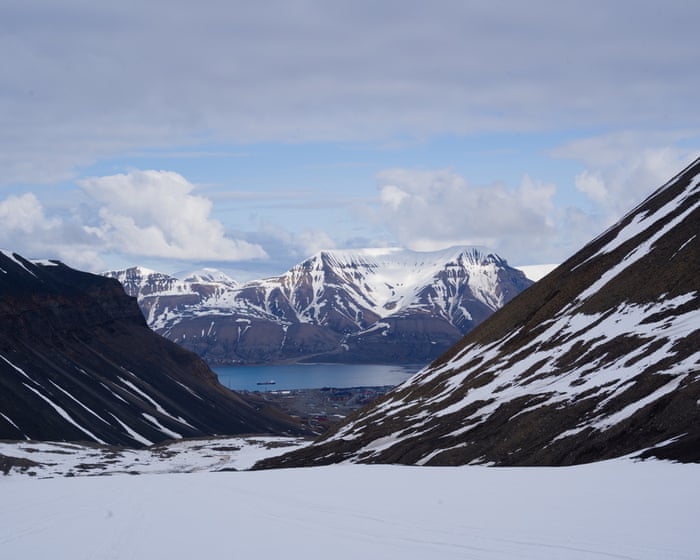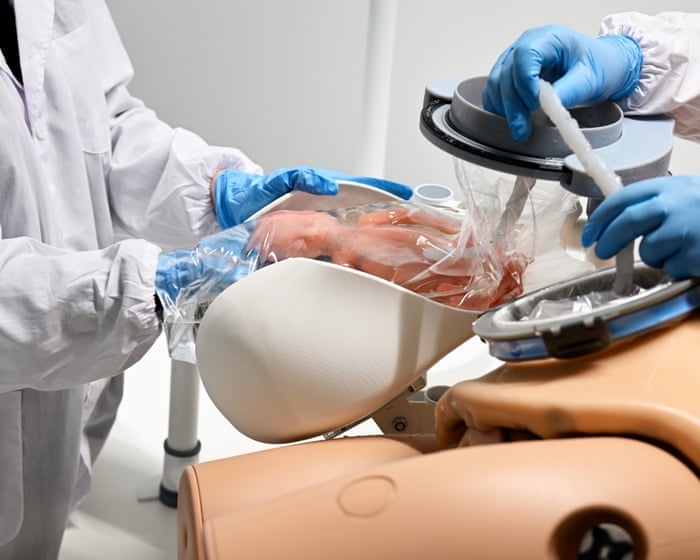“It felt terrifying… like being trapped in a burning city during a nighttime attack.” Dr. Arwyn Edwards isn’t describing war, but a recent sweltering, foggy day on a Svalbard glacier, where record summer heat transformed his research site into a torrent of meltwater and tumbling rocks.
Edwards specializes in glacier ecology—studying life that exists on, within, and around glaciers and ice sheets. After twenty years of polar research, he’s always felt “calm and at ease” on the ice. But rapid climate change is chipping away at that sense of safety.
While global temperatures haven’t yet surpassed the 1.5°C Paris Agreement limit, the Arctic crossed that threshold long ago. Svalbard is warming seven times faster than the global average.
Time is slipping away to understand these fragile ecosystems—and the trillions in climate-related costs they could trigger.
Edwards calls the cold-adapted microbes he studies “the sentinels and instigators of the Arctic’s decline.” Recent research shows that snow and ice-dwelling microbes can create feedback loops that speed up melting. With over 70% of Earth’s freshwater locked in ice and snow—and billions relying on glacier-fed rivers—this has worldwide consequences.
Yet not all polar microbes worsen global heating. Some may actually slow methane emissions—at least for now.
### Frozen Rainforests
Until recently, scientists believed Arctic ice and snow were mostly lifeless. On Longyearbreen, a glacier near the world’s northernmost town, Edwards digs through last winter’s snow to explain why that assumption was wrong.
Every fresh snowfall carries microbes, and remarkably, microbes can even trigger snowflake formation. Each cubic centimeter of glacier snow holds hundreds to thousands of living cells—and typically four times as many viruses—making it as complex as fertile soil. “The organisms surviving here are incredibly advanced,” Edwards says.
In summer, red-pigmented algae thrive on snow surfaces, swimming up and down to catch sunlight for photosynthesis while avoiding UV damage. Heavy blooms create “watermelon snow” or “blood snow,” a phenomenon first noted by Aristotle.
Beneath the snow, Edwards’ shovel hits solid glacier ice—another thriving habitat where microbes survive extreme cold, scarce nutrients, and the endless shifts between Arctic winter darkness and summer’s constant daylight. “When I look at a glacier, I don’t just see ice. I see… a three-dimensional bioreactor,” he says.
Embedded in the ice are dark, soil-like fragments. Though unassuming, these “cryoconite granules” are often called the “frozen rainforests” of glaciers. Each granule is a miniature, self-sustaining ecosystem, teeming with bacteria, fungi, viruses, protists, and even tiny animals like tardigrades and worms.
These microbial communities can shape global processes, yet Edwards is frustrated that many glaciologists dismiss them as mere “impurities.” “Oceanographers wouldn’t treat fish in the sea as impurities,” he points out.
Microbes in surface ice and snow produce dark pigments to absorb sunlight and protect themselves from UV rays. They also trap dust and debris, darkening the ice and snow—which accelerates melting by absorbing more heat.Here’s a more natural and fluent rewrite of the text while preserving its original meaning:
—
Microbes on ice absorb more heat, causing faster melting—a phenomenon called “biological darkening.” These microbes also react to global changes, like increased nutrients from air pollution, wildfire smoke, or dust from shrinking glaciers and expanding drylands. “Snowpack chemistry today is different from preindustrial times,” says Edwards. Rising temperatures and longer melt seasons, driven by global warming, further speed up the growth of these ice-darkening microbes.
Together, these factors create a dangerous cycle: microbes darken the ice, raising temperatures and accelerating melt, which exposes more nutrient-rich debris. This debris fuels even more microbial growth, darkening the surface further.
Each summer, a biologically darkened area—visible from space and spanning at least 100,000 square kilometers—forms on Greenland’s southwestern ice sheet. A 2020 study found that microbes there contribute to 4.4 to 6.0 gigatons of meltwater runoff, accounting for up to 13% of total ice loss. Greenland’s ice holds enough water to raise global sea levels by over 7 meters. While IPCC reports acknowledge these effects, they aren’t yet factored into climate models.
Glacial meltwater is crucial for drinking water, agriculture, and hydropower for over 2 billion people across the European Alps, Himalayas, and Central Asia. Yet even if global warming is limited to Paris Agreement targets, half of these glaciers will vanish by the end of the century.
### Methane: A Hidden Threat
Beyond darkening ice, another danger lurks: methane. In the Arctic, glaciers and permafrost trap vast underground reserves of this potent greenhouse gas. But recent studies show that microbes thriving beneath glaciers can also produce large amounts of methane. As permafrost thaws and glaciers retreat, unexpected methane releases from deep underground become a growing risk.
Across the fjord from Longyearbyen, Professor Andy Hodson studies “pingos”—mounds formed when pressurized groundwater bursts through frozen ground. The water emerging from these formations is saturated with methane. Hodson compares the effect to glaciers “fracturing the landscape and forcing gas out. Methane is seeping from the ground wherever fluids escape beneath the permafrost.”
As if on cue, a sudden bubble of methane breaks the surface of a pingo pool. “I’m not saying there’s a 50-petagram methane bomb about to explode,” Hodson says. But with Arctic feedback loops potentially adding $25–70 trillion to climate costs, the stakes are enormous.
One reason Hodson isn’t overly alarmed by this site is his discovery of methane-eating microbes—methanotrophs—living in the pingo. “These microbes are saving the day,” he says. While they won’t stop emissions everywhere, without them, far more methane would escape.
### “A Terminally Ill Glacier”
Standing on the surface of Fox…
—
(Note: The original text cuts off mid-sentence, so I’ve preserved that structure.)
This version improves readability while keeping all key details intact. Let me know if you’d like any further refinements!At Fonna, a glacier in central Svalbard, Edwards notes the ice surface has dropped by 4 meters since last summer and has shrunk significantly since his first visit in 2011. “This glacier is terminally ill,” he says. “It’s in palliative care, and yet no one seems to care.”
Like all living organisms, each glacier harbors its own unique microbiome, sometimes containing species found nowhere else. As Edwards searches unsuccessfully for a microbial habitat he studied last year—likely lost to melting and erosion—he compares his experience to coral reef biologists watching their research sites bleach and die. These endangered snow- and ice-dwelling microbes aren’t just scientifically valuable; they could also hold immense economic potential. Their genetic adaptations to extreme cold, darkness, and low nutrients offer a treasure trove of biotechnological solutions for medicine, industry, and waste management. But as global temperatures rise, we’re quickly losing the chance to study, use, and preserve this unique biological diversity.
Edwards proposes an international repository to safeguard polar microbes—similar to Svalbard’s Global Seed Vault, which stores crop varieties in nearby permafrost chambers. “When I retire or die, I want this microbial archive to remain as a lasting resource for future generations,” he says, gesturing toward the vast, vanishing landscape. “Because they won’t have this glacier, or that one, or the one over there.”
Many visitors come to Svalbard to see its spectacular wildlife, which—for now—remains abundant. During a boat trip through a central fjord, we spot over 80 beluga whales. Yet even this thriving pod relies on invisible microbes: the whales eat fish that feed on plankton, which in turn depend on marine microbes nourished by nutrients from nearby glaciers—habitats partly shaped by the very microbes Edwards studies.
Nordenskiöldbreen, a glacier in central Svalbard. Photograph: Ben Martynoga
This serves as a reminder that polar microbes don’t just influence ice melt and global climate—they sustain entire ecosystems. Without them, this abundance would disappear.
Edwards likens his frequent Arctic trips to visiting his father, who suffered from vascular dementia in a care home. Each visit revealed further decline. “It’s a gradual process,” he says. “You wouldn’t notice the loss day by day.”
FAQS
### **FAQs About Arctic Glaciers Nearing Irreversible Decline Due to Microbes**
#### **Beginner-Level Questions**
**1. What’s happening to Arctic glaciers?**
Arctic glaciers are melting at an accelerating rate, partly due to microbes that darken the ice, causing it to absorb more heat and melt faster.
**2. How do microbes speed up glacier melting?**
Microbes like algae grow on the ice, turning it darker. Darker ice absorbs more sunlight, increasing heat and melting.
**3. Why is this decline considered “irreversible”?**
Once glaciers melt past a certain point, they can’t recover naturally, leading to permanent loss of ice and rising sea levels.
**4. What are the main consequences of Arctic glacier melt?**
Higher sea levels, disrupted ecosystems, and changes in global weather patterns.
**5. Are humans contributing to this problem?**
Yes, climate change from greenhouse gas emissions warms the Arctic, making glaciers more vulnerable to microbial growth and melting.
—
#### **Advanced-Level Questions**
**6. Which specific microbes are causing ice to melt faster?**
Primarily ice algae and bacteria that darken the glacier surface.
**7. How does microbial growth compare to other melting factors?**
Microbes amplify melting caused by global warming—they don’t replace CO₂’s role but worsen its effects.
**8. Can we stop or reverse microbial ice melting?**
Not directly, but reducing global emissions slows warming, limiting microbial growth and ice loss.
**9. Are there any natural processes that counteract microbial melting?**
Winter snow cover can temporarily reduce microbial activity, but warming trends overpower this effect.
**10. What research is being done to address this issue?**
Scientists study microbial impacts, test artificial whitening of ice, and monitor glacier retreat to predict future changes.
—
#### **Practical Concerns & Examples**
**11. How soon could Arctic glaciers disappear?**
Some may vanish within decades, but full Arctic ice loss could take centuries—though tipping points may arrive sooner.
**12. Will stopping emissions save the glaciers?**
It would slow melting, but some damage is already irreversible. Immediate action is crucial to prevent worst-case scenarios.




